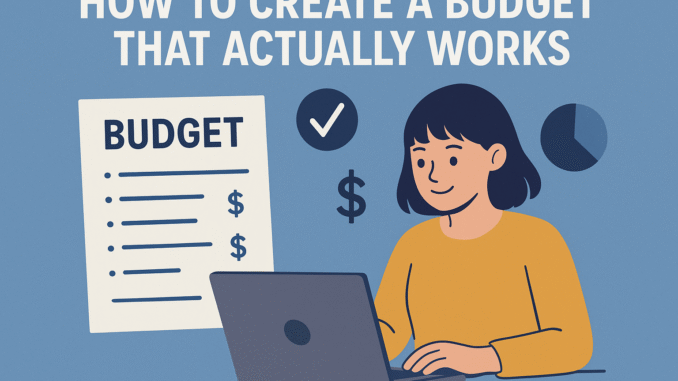
How to Create a Budget That Actually Works: A Step-by-Step Guide for Beginners
Managing money can feel overwhelming, especially when expenses seem to pile up faster than your income. But here’s the truth — a well-planned budget isn’t just about cutting costs; it’s about taking control of your financial life and making your money work for you.
Whether you’re trying to save for a big goal, pay off debt, or simply stop living paycheck to paycheck, this guide will walk you through how to create a budget that actually works — simple, realistic, and easy to maintain.
Why You Need a Budget
A budget isn’t a punishment — it’s a financial roadmap. It shows you where your money is going and helps you make informed decisions about how to spend, save, and invest it.
Here are a few reasons why budgeting is crucial:
- It helps you avoid debt and pay bills on time.
- It reveals your spending patterns and areas where you can cut back.
- It allows you to plan for future goals like buying a home, traveling, or retiring comfortably.
- It provides peace of mind by reducing financial stress.
The key is to create a budget that fits your lifestyle — one that’s realistic, flexible, and sustainable.
Step 1: Know Your Why
Before diving into the numbers, define why you want to budget.
Do you want to save for a house? Pay off student loans? Build an emergency fund? Your motivation gives purpose to your budget and keeps you disciplined.
Write down your main financial goals — both short-term (saving $1,000 in 3 months) and long-term (retire early, travel the world, start a business).
Your “why” will keep you on track when the temptation to overspend hits.
Step 2: Track Your Income
The next step is to know exactly how much money you make each month. This includes:
- Your main salary or wages
- Freelance or side hustle income
- Bonuses, commissions, or tips
- Rental income or passive income streams
If your income fluctuates, calculate your average monthly income from the last 3–6 months to get a realistic estimate.
Once you know your total income, you can begin allocating it strategically across different spending categories.
Step 3: List All Your Expenses
You can’t control what you don’t measure. Tracking your spending helps you identify where your money is going and what’s truly necessary.
Start by listing all your monthly expenses, including:
Fixed Expenses
These stay the same each month:
- Rent or mortgage
- Utilities (electricity, water, internet)
- Insurance (health, car, home)
- Loan or debt payments
- Subscriptions (Netflix, gym, etc.)
Variable Expenses
These fluctuate depending on your lifestyle:
- Groceries
- Transportation or fuel
- Dining out
- Shopping
- Entertainment
Don’t forget annual or irregular expenses, like car maintenance or holiday gifts — divide them by 12 and include them in your monthly budget to avoid surprises.
Step 4: Categorize and Prioritize Your Spending
Once you’ve identified your expenses, it’s time to categorize them based on importance.
A simple and effective method is the 50/30/20 rule:
- 50% for Needs: Essentials like rent, food, transportation, and bills.
- 30% for Wants: Non-essentials like dining out, hobbies, or entertainment.
- 20% for Savings and Debt Repayment: Emergency fund, investments, or extra loan payments.
This method gives you flexibility while ensuring your money is used wisely.
If you’re paying off high-interest debt, consider adjusting to 60/20/20 — allocating more to necessities and debt until you regain financial balance.
Step 5: Set Realistic Financial Goals
Budgeting isn’t just about tracking — it’s about planning for the future.
Set specific, measurable, and realistic goals that align with your financial situation. For example:
- Save $500 per month toward an emergency fund.
- Pay off a $3,000 credit card balance in 10 months.
- Invest 10% of your income in an index fund.
Break big goals into smaller milestones so you can celebrate progress along the way. This helps you stay motivated and consistent.
Step 6: Choose a Budgeting Method That Fits Your Lifestyle
There’s no one-size-fits-all approach to budgeting. Here are a few popular methods — choose one that matches your habits and goals.
1. Zero-Based Budget
Every dollar you earn is assigned a purpose. Income minus expenses equals zero.
This method gives you total control but requires consistent tracking.
2. Envelope System
Great for cash users — allocate money to physical envelopes labeled by category (e.g., groceries, gas, dining). When an envelope is empty, you stop spending.
Today, digital envelope apps like Goodbudget offer a modern version.
3. 50/30/20 Budget
Simple and beginner-friendly. Divide your income into percentages as described earlier. It provides flexibility without overcomplication.
4. Pay-Yourself-First Method
Automatically transfer a set percentage of your income to savings or investments before spending on anything else.
This ensures saving becomes a habit, not an afterthought.
Choose the method that feels natural to you — the best budget is the one you’ll actually stick to.
Step 7: Use Tools to Make Budgeting Easier
In today’s digital world, budgeting has never been easier. There are many free and paid tools that automate tracking, categorize expenses, and show spending insights.
Here are a few popular options:
- Mint – Free and easy to use; connects to your bank accounts.
- YNAB (You Need a Budget) – Teaches proactive budgeting and helps you plan ahead.
- EveryDollar – Created by Dave Ramsey; focuses on zero-based budgeting.
- Google Sheets/Excel – Perfect for those who prefer a custom DIY spreadsheet.
Pick a tool that fits your style and helps you stay consistent.
Step 8: Build an Emergency Fund
An essential part of any working budget is an emergency fund — money set aside for unexpected events like medical bills, car repairs, or job loss.
Aim to save 3–6 months’ worth of living expenses in a separate, easily accessible savings account.
This safety net ensures you won’t go into debt when life throws you a curveball.
Step 9: Review and Adjust Regularly
A budget isn’t a one-time setup — it’s a living document that evolves with your life.
Review your budget monthly to see:
- Did you overspend in any category?
- Can you increase your savings rate?
- Have your goals or income changed?
Adjust your budget accordingly. Flexibility is key — your budget should work for you, not against you.
If something doesn’t work, tweak it. Budgeting success is about consistency, not perfection.
Step 10: Stay Disciplined — But Reward Yourself
Budgeting requires discipline, but it shouldn’t feel restrictive. Allow yourself small rewards for hitting milestones — like a nice dinner out after saving a specific amount or paying off a debt.
These small celebrations keep you motivated and make the process enjoyable.
The trick is balance: enjoy life today while securing your future.
Bonus Tip: Automate Everything You Can
Automation helps remove human error and temptation from the equation.
- Set up automatic bill payments to avoid late fees.
- Automate transfers to your savings or investment accounts.
- Use apps that track spending in real time to prevent overspending.
By automating your finances, you make good habits effortless — and that’s the real secret to a budget that lasts.
Common Budgeting Mistakes to Avoid
Even the best plans can fail if you fall into these traps:
- Setting unrealistic goals — You’ll give up quickly if your budget feels impossible.
- Ignoring small expenses — Daily coffees or subscriptions add up over time.
- Not tracking spending — Awareness is the foundation of financial success.
- Skipping emergency savings — Without one, a single crisis can undo your progress.
- Being too strict — Leave room for fun; otherwise, burnout is inevitable.
Learning from these mistakes will make your budget more effective and sustainable.
Final Thoughts
Creating a budget that actually works isn’t about restriction — it’s about freedom. It gives you control, clarity, and confidence in every financial decision you make.
Start simple: track your income and expenses, set realistic goals, and choose a budgeting method that fits your lifestyle. Over time, you’ll find that budgeting becomes second nature.
Remember, the goal isn’t perfection — it’s progress. Small, consistent steps today can lead to major financial freedom tomorrow.
So take that first step today — create your budget, stick to it, and watch your money start working for you.

